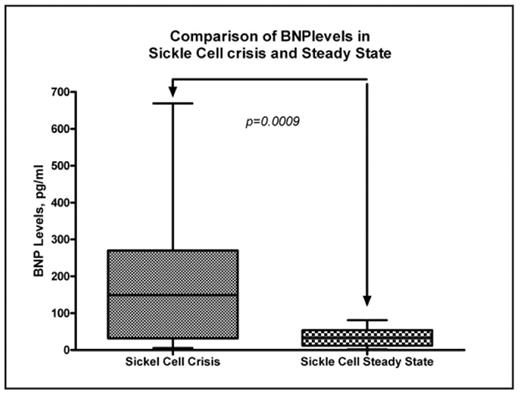Abstract
Background: The heart is frequently involved in Sickle Cell Anemia (SCA). Cardiomegaly is a usual finding, significant arrythmias and sudden death are common, and 30% of patients with both homozygous and heterozygous SCA develop Pulmonary Arterial Hypertension (PAH), a major risk factor for higher mortality in this population. Brain Natriuretic Peptide (BNP) and echocardiographic data could provide important prognostic and diagnostic information about PAH in SCD. High levels of BNP, which is released from ventricular cardiomyocytes in response to their stretch, reflect cardiac chamber volume and pressure overload in various conditions. In patients with PAH, BNP levels correlate with the severity of Pulmonary Artery Pressure (PAP) elevation and right ventricular dysfunction. In human, the half life of BNP is 20 minutes, reflecting the fluctuation of BNP levels during different stages of any acute cardiac pathology.
Methodology: The hypothesis of this prospective IRB approved study was to investigate the BNP level and PAP elevation during an acute Sickle Cell Crisis (SCC), in particular in those with intrathoracic structures involvement. Between December 2006 and July 2008, 81 patients were registered after a written informed consent was obtained. We collected the BNP levels and echocardiographic data of patients with SCD and compared them in two group; those who were admitted with Sickle Cell Crisis (SCC) and those who returned to clinic in Steady State (SS) for follow up. The data were obtained on the first day of admission in SCC group. The primary endpoint was the elevation of the BNP level and the secondary endpoint was elevation of the PAP during a SCC, which were compared with SS patients. The inclusion criterion was age above 18 and having one of the sickle cell syndromes, requiring hospital admission.
Results: Forty nine patients (59%) were female, and 34 (41%) patients were male. Their ages ranged from 19 to 65, mean (SD) 30.2 (9.7) years. The mean (SD) levels of BNP were significantly higher in patients who were admitted with one of the acute complications or vaso-occlusive crisis of sickle cell, [177.3 (23.4) pg/ml], when compared with its levels in SS, [34.17 (6.1) pg/ml], (95% CI 61.4 to 225.0, p<.001) (Figure 1). An elevated BNP level was defined as levels more than 100 pg/ml. A further subgroup analysis revealed that the BNP levels were even more significantly higher in patients with acute chest syndrome or other intrathoracic events [(n= 17, mean (SD) 363.6 (121.3) pg/ml], when compared with those of simple acute sickle cell crisis, [(n= 35, mean (SD) 167.7 (26.8) pg/ml] (p=.038) (Figure 1). Topographic data about heart chambers’ sizes, volumes, and pressures were obtained by Echocardiography and compared in two groups. While only 23.1% of patients in SS group had elevated PAP with a mean (SD) of 43 (2.1) mmHg, 41.1% (n=21) of patients with SCC had elevated PAP with mean (SD) 45.9 (2.1) mmHg, with no significant difference between two groups with PAH (p=.608).
Conclusion: Patients with either homozygous or heterozygous forms of SCA can have cardiac complications, such systolic and diastolic dysfunction. Hypoxemia leads to raised levels of BNP production. In patients with SCA, an elevated BNP level largely reflects the severity of right ventricular dysfunction associated with PAH. Our data revealed that BNP level and PAP are increased during vaso-occlusive crisis of SCA, in particular during those life-threatening complications, such acute chest syndrome. These changes seem to be temporary and with clinical improvement, the majority of patients’ BNP levels and PAP return to the baseline, although some will never normalize.
Disclosures: No relevant conflicts of interest to declare.
Author notes
Corresponding author


